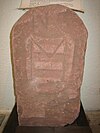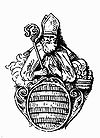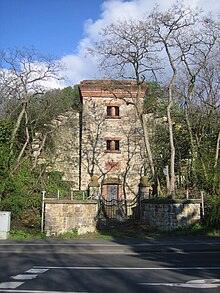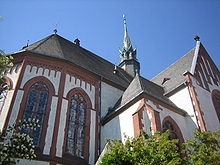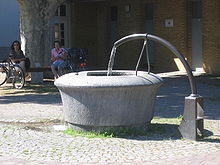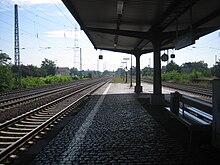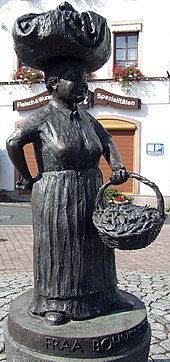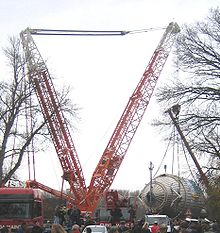Mainz-Mombach
|
Mombach district of Mainz |
|||||||||||||
|---|---|---|---|---|---|---|---|---|---|---|---|---|---|
| Coordinates | 50 ° 1 '10 " N , 8 ° 13' 40" E | ||||||||||||
| height | 85 m above sea level NN | ||||||||||||
| surface | 6.316 km² | ||||||||||||
| Residents | 13,967 (Dec. 31, 2019) | ||||||||||||
| Population density | 2211 inhabitants / km² | ||||||||||||
| Proportion of foreigners | 27.2% (Dec. 31, 2019) | ||||||||||||
| Incorporation | Apr 1, 1907 | ||||||||||||
| Post Code | 55120 | ||||||||||||
| prefix | 06131 | ||||||||||||
Administration address |
Hauptstrasse 136 55120 Mainz |
||||||||||||
| Website | www.mainz.de | ||||||||||||
| politics | |||||||||||||
| Mayor | Christian Kanka ( SPD ) | ||||||||||||
| Allocation of seats (local advisory board) | |||||||||||||
|
|||||||||||||
| Transport links | |||||||||||||
| tram | MVG lines 50, 51 | ||||||||||||
| bus | MVG lines 60, 61, 62, 63, 71, 74, 76, 92, ORN line 620 | ||||||||||||
Mombach is a district of the Rhineland-Palatinate state capital Mainz .
The place with today almost 14,000 inhabitants developed through industrialization in the middle of the 19th century to a wealthy industrial community in the Grand Duchy of Hesse , which was incorporated into the city of Mainz in 1907. Since the recession of the 1970s and the associated plant closings, Mombach has undergone a structural change towards a residential and commercial location. The high proportion of foreigners also comes from that time. With 27 percent of registered foreigners and a double-digit percentage of registered Germans with a migration background , Mombach is the district of Mainz with the highest proportion of the population with a migration background. Mombach can be reached directly via Mainz or via the A 643 motorway from all directions, at the Mainz-Mombach or Mainz-Gonsenheim junction . The Mainzer Sand nature reserve is largely located in the district and the adjacent Lenneberg Forest extends the area suitable for recreation. The Mombacher Rheinufer with its nature reserve and the water sports clubs complement the recreational offer.
geography
Mombach lies in the receded foreland to the left of the Rhine in the Mainz basin and thus on the edge of the Rhine-Hessian plateau. The Rhine forms the northern boundary of Mombach.
Mombach is the northernmost district of Mainz.
Neighboring districts and municipalities
The following municipalities or districts of Mainz and Wiesbaden border Mombach in a clockwise direction:
in the north over the Rhine Wiesbaden-Schierstein and Wiesbaden-Biebrich , in the east Mainz-Neustadt , in the south Mainz-Gonsenheim and to a small extent Mainz-Hartenberg-Münchfeld and in the west Budenheim .
climate
Like all of Rheinhessen, Mombach is sheltered from the weather by the Hunsrück , Taunus , Odenwald and Donnersberg mountains .
Local history
Mombach was originally a farming, boatman and fishing village.
Early history and the Middle Ages
Archaeological excavations show that the area of Mombach was already inhabited in prehistoric times. For example, a flat ax was found in Mombach from the Early Bronze Age . There are also numerous finds from Roman times. The place was probably founded in the course of the Frankish conquest . During this time Mombach arose, probably from the Frankish name Muno (Munno) or the Celtic Mouno . The place name is interpreted as a brook settlement of the Munno. Mombach was first mentioned in a document in 1256.
France's urge to the Rhine
During the Thirty Years' War , with changeable occupiers of Mainz and the surrounding area (including Sweden surrender of Mainz on December 23, 1631 and imperial ones), the French advanced to Mainz in 1635 under the command of Viscount de Turenne , where he met Bernhard von Sachsen- Weimar appalled . Due to a lack of money and provisions, the city could not be held and fell to the imperial family on December 17, 1635. On September 17, 1644, Mainz became French again after the French siege. When the garrison was weakened by the Turkish wars, the French returned and in 1688 they devastated and occupied the areas on the left bank of the Rhine up to the natural Rhine border including Mainz without declaring war. The occupied city was besieged and recaptured by imperial troops in the Palatinate War of Succession in 1689 .
Kurmainzer time
In Kurmainzer times the place was surrounded by a village wall. Parts of this village wall are still part of old barns today. Mombach's historic center is Lindenplatz. The most important buildings, the first Nikolauskapelle, the baking house and the school house are grouped around the old village linden. As the boundary stone research shows, in addition to the Mainz cathedral monastery, the Dalheim and Jakobsberg monasteries were also demonstrably wealthy in Mombach during this period.
The original parish church of Mombach was St. Theonest in the garden field. The village and its district was in the penal immunity of St. Peter . It is believed that the old Nikolauskapelle fell victim to the devastation of the Palatinate War of Succession. As a replacement, the first Nikolauskirche was consecrated on August 19, 1703 by the Auxiliary Bishop Johann Edmund Gedult von Jungsfeld from Mainz, making Mombach independent of the pin nobility in St. Peter. Shortly before his death, the cathedral vicar Heinrich Georg de La Roche provided the necessary funding in the form of a foundation of 1000 thalers . On December 14, 1700, the agreement between St. Peter's Monastery and the community was concluded. The church was under the supervision of the Provost of Mainz. During the following time, a new town hall and school house were built. In the middle of the 18th century there was an enthusiasm for country life among the aristocrats, from which Mombach was able to benefit. Evidence for this is e.g. B. the layout of the "Walderdorfschen Geländes", the "Kesselstadtsche Anlage" and the "Rondell".
Second French occupation
In 1792 General Custine lifted the electoral administration. With the renewed occupation of the area on the left bank of the Rhine by the French Revolutionary Army , the administration of Mombach's foundation by officials of the cathedral chapter was completely ended. During the siege of Mainz (1793) , Mombach was repeatedly plundered by both warring parties. Even when the French wanted to recapture Mainz ( Mainz lines ), the troops stood between Mombach and Budenheim. On November 12, 1794, a hill near Mombach was occupied by Generals Desaix and Michaud . The relief of Mainz began on October 29, 1795 so that the clerfait initiated a mock attack on Mombach, both from Hartenberg and Hartmühle, as well as from Ingelheimer Aue . With the Peace of Campo Formio and its confirmation in the Peace of Lunéville , Mombach was added to the French and from then on was in the canton of Oberingelheim . From 1801 the Prefect Jeanbon St. André resided in Mainz and had the old town gates and various holy houses in Mombach closed.
During this time, the extensive, low-lying fields and meadows along the Rhine were drained by means of a system of dams and ditches. In the event of a siege , the garden field in front of the western outer wall could be flooded by means of a system of dams and locks, the Inondationsschanze , installed near the city . This allowed the defenders to concentrate on the lines of the south and east walls. The largely watery soil made it difficult for potential besiegers to create drinking water wells, trenches, communication routes as well as dry accommodation and batteries.
Grand Ducal Hessian period
After the failure of Napoleon , the Congress of Vienna and the State Treaty on Frankfurt am Main , the areas around Mainz, Bingen , Alzey and Worms became part of the Grand Duchy of Hesse after the Middle Rhine General Government was replaced . Since then this area has been known as Rheinhessen . Mainz became a federal fortress . Numerous fruit fields, vineyards and forests were converted to military grounds . In the middle of the 19th century, the rural community benefited from its proximity to the Mainz fortress , as according to the rayon regulations , no industrial settlements were allowed within the second rayon line. That is why the Mainz merchants resorted to locations such as Mombach or the areas on the right bank of the Rhine for their production facilities. In 1845 the chaise and railway car factory of the Gastell brothers from Mainz was forcibly relocated . Such large fire-processing factories were no longer allowed to produce inside the fortress walls for safety reasons. It was decided in favor of Count von Walderdorf's facility on the outskirts of Mombach. With the completion of the Mainz-Bingen railway line in 1859, the Mombacher received their first passenger and freight station, which promoted both agricultural and industrial production. The establishment of the chemical factory in 1856, now Prefere Paraform , made a significant contribution to this . As early as 1825, the first Mainz “gymnastics area” was set up near Mombach on today's “Kleine Sand”. In 1869 the first gymnasium and the school building were built on the main street. The increasing industrialization in the early days after the Franco-Prussian War of 1871/71 later resulted in the immigration of mainly working-class families. Another railway line, the Hessische Ludwigsbahn , was run along the Gastell company premises in the direction of Gonsenheim in 1871, and another train station was built. In 1885 the population consisted of 2,822 people, including 485 Protestant Christians, who promoted the establishment of a Protestant community in the same year.
Today's industrial port was built as a raft port from 1882 to 1887 by partially filling in the arm of the Rhine to Ingelheimer Aue to create the basin for the Mainz customs and inland port upstream.
In August 1890 the Schmahlsche Kesselschmiede started operations. Soon afterwards a new school building was built in Weiherstrasse.
20th century
At the beginning of the 20th century, Mombach received gas and water pipes and a sewer system - the gas and water works were created. The most important disk gas container of its time was in Mombach. In addition, the electric tram connected Mombach with Mainz.
On April 1, 1907, Mombach was incorporated as one of the first suburbs under Lord Mayor Karl Göttelmann . As a result, Mainz grew into a real city with over 100,000 inhabitants in the following year . The waterworks for the hygienically perfect supply of water has been expanded. The Pestalozzi School, a three-storey two-wing building, was built in 1908/1909 based on a design by the Mainz Building Department. The sculptural work was carried out by Ludwig Lipp senior . A public bath was also integrated into this facility . With the rapid growth of the last few years, the social question also arose in Mombach . In connection with this growth, further church buildings were necessary, so on April 10, 1910, the Protestant community laid the cornerstone for the “Friedenskirche” in the style of the Wiesbaden program ; Ketteler are planning the “Herz-Jesu-Kirche”.
For many years, imperial maneuvers, beginning with the imperial parades , were held on the Großer Sand , the last time in 1913. Kaiser Wilhelm II . took this off when he was in Wiesbaden for a cure.
The First World War marked a historical turning point in the development of Mainz and Mombach . In 1918 the French reoccupied Mainz and the Rhineland, they did not leave it until 1930, and the economic situation deteriorated. Large areas of the military area at the Polygon were sold to agriculture for the construction of orchards. In 1937 the Kathenkaserne was completed , partly on Mombacher, partly on Gonsenheim district.
Until after the Second World War , Mombach was idyllically situated on Rettbergsaue and Ingelheimer Aue and had a natural swimming pool with the legendary lifeguard Lenges, who saved 37 people from drowning. Since the loss of the suburbs on the right bank of the Rhine, Amöneburg, Kostheim and Kastel, as well as Bischofsheim, with what was then the largest freight station, as a result of the zoning of the Allies, Mombach has been converted into an industrial location. Ultimately, Mainz had not only lost its suburbs, but also 50% of its area and most of its industry. The raft harbor was partially filled with the rubble from the air raids on Mainz and offered space for industrial settlements. Mombach is still characterized by a cozy town center with old houses such as B. the local administration, shops and craft businesses.
The Mainz central sewage treatment plant was built in 1960. The Mombach indoor pool was opened in 1970, and in 1975 the outdoor pool with 70,000 m² of green space and 180 trees was opened. Since 2006 it has been working under the sponsorship of the Mainz swimming club from 1901.
In 2006 the Mombacher celebrated their 750th anniversary. This celebration goes back to a documented mention of 1256, but the place is definitely older.
List of mayors
- 1907–1934 Heinrich Freber
- 1934 - ???? Georg Gönner
- 1936–1945 Richard Lotz
- 1945–1958 Daniel Weingärtner
- 1958–1967 Friedhelm Schneider
- 1967–1983 Karl Unkel
- 1983–1995 Ursula Distelhut
- 1995–2002 Michael Ebling
- 2002–2019 Eleonore Lossen-Geißler
- 2019 – today Christian Kanka
District coat of arms
Old coat of arms
In Mombach itself there is no representation of an old coat of arms that would suggest the history and affiliation to different owners. Already in the early Middle Ages Mombach belonged to the property of the Archbishopric Mainz, which gave the place as a man's fief. In the 14th century the ownership rights passed to the Mainz cathedral chapter and belonged to St. Peter until the Napoleonic times . Therefore the colors of the cathedral chapter silver / red are preserved in most of the old coats of arms. In the coat of arms around 1500, in addition to the colors of the cathedral chapter, there are three red gold balls in the upper right corner of the coat of arms, which indicate the outfitter of the three virgins through dowry donation, St. Nicholas , the patron of the boatmen.
The red / silver stripes are also a focal point on the 1741 judgment seal. The seal is based on older models, but is decorated in a typical baroque style . It shows St. Nicholas of Myra, the patron of the parish church built in 1703, floating above the clouds with his crosier. The bishop is assigned three boys in a curing barrel as an attribute, which, according to legend, the saint brought back to life.
New coat of arms
Mombach did not have its own coat of arms from the time the French cantons were divided up until Mombach was incorporated into Mainz. The place was assigned with Josef Zey, Mombacher Maire adjoint , the Budenheimer Maire in the canton of Oberingelheim . With the construction of the new Mainz town hall from 1971 to 1974, the coats of arms of all parts of the city were to be placed in the entrance hall in chronological order of incorporation, from bottom to top. Therefore, the city hall decided to have a new coat of arms designed for Mombach, as the traditional depiction with the figure of St. Nicholas was no longer considered to be contemporary. The Mainz heraldist Heinz Leitermann was commissioned to create a modern, speaking coat of arms for Mombach. This new coat of arms is divided into four fields, the motifs of which refer to Mombach's past and present.
The top two fields refer to the history of the parish. The right part shows the cathedral chapter shield with its characteristic red stripes on a silver (now white) background, an indication of the previous ownership. To the left of it is a golden crosier and three golden balls on a blue background, which are supposed to remind of the patron saint St. Nicholas. The present of 1974 is symbolized on the two lower fields. The right field with crossed spades and karst in silver on a green background indicates the agriculture that still existed at the time. The black, lying gear on a silver background points to the industry that settled in Mombach from 1856 and increasingly after the war.
Buildings worth seeing
- Old waterworks (1904), historicizing tower-like boss block construction of the Grand Ducal Cultural Inspectorate in Mainz ( Bruno von Boehmer )
- House Pestalozzistraße 4 (1900), sandstone-integrated brick building from the late 19th century, two-story winter garden, by Valentin Braunbeck
- Herz-Jesu Church (Catholic, 1911) in neo-Gothic style designed by Ludwig Becker , design of the glass windows by Alois Plum , after safeguarding and renovation the chancel was painted in 2001 by Vitus Wurmdobler .
- Catholic local church St. Nikolaus (1955), equipped with a central chancel before the Second Vatican Council , altar and stations of the cross design by Heinz Hemrich , glass wall in the chapel by Peter Paul Etz
- Protestant Peace Church (1911), building group in neo-classicist Art Nouveau by Reinhold Weisse, hall building, parsonage with hipped roof, nurses' house with crooked hipped roof;
- former evangelical prayer house from 1891 ( Emrichruhstraße , next to Gastell's hospice)
- Schoolhouse with teachers' apartments from 1869 (opposite the Nikolauskirche, today kindergarten). Ensemble: three-storey hipped roof building with knee-high floor, heightened in 1885. Former syringe house: small brick building with hipped roof. Teacher's apartment as a three-part, single-storey quarry stone building with knee floor, which was probably built around 1885.
- Jahnschule, school building in Weiherstrasse (1894), red brick building with sandstone decorations
- Pestalozzi School (1912), plastered building with extended mansard or mansard hipped roof, design of the Mainz Building Department, sculptural work by Ludwig Lipp senior
- Former hospice of the Gastell brothers, later Rochus Hospital, today Caritas Center
- Local museum in the old pump house (1904), single-storey half-hipped roof building with half-timbered gable and knee, by Wilhelm Lenz
- Local administration, sophisticated late-classical plastered building, around 1875 with older parts
- Industrial monument wagon factory with Phoenix Hall, today Hall 45
- Kreuzkapelle with Crossroads (1814) open classical construction with cross roof, as paths Chapel after the liberation wars built
- Terraced house settlement “Am Mahnes” for workers, started in 1921 ff. By the non-profit building cooperative Mainz-Mombach according to plans by the building contractor Franz Vlasdeck, two-storey rows of houses with front gardens, rear garden plots and small cattle sheds; as a document of the construction of small settlements in the 1920s
- Tenement complexes Am Suderbrunnen 6, Emrichruhstraße 49/51/53, Pestalozzistraße 20/22/24, Zeystraße 15/17, 19: made up of pairs of couples put together to form semi-detached houses, simple home style from the 1920s, document of Mainz's social history
Parks
- De La Roche facility : Today it stands on the spot where the Emmerichsruhe was located in the 18th century, a bosket of Archbishop Emmerich Joseph von Breidbach zu Bürresheim at a spring. The adjoining Emrichruhstraße still remembers the Elector today.
- Park in the old cemetery (Am Lemmchen)
- At the reminder
- Franz Vlasdeck facility
- Green area at the Holy Spirit
- The city of Mainz's only natural playground on Köppelstrasse
According to a social space study carried out on behalf of the City of Mainz in 2005, the Am Westring district is the area with the best ratio of residential to green spaces. In a study on the perception of the place and the connection with the place of Mombach from 1999, the endogenous potential of the district was shown. This fact is probably due to the urban planning by Ernst May , who propagated Mombach West in order to relieve the inner city and thus contribute to the loosening of the existing development in it.
Natural heritage
- Sand dunes in the Mombacher Sand
- Bird sanctuary around the old waterworks
- Headwaters between the plantation and Erzbergerstrasse
Sporting opportunities
There are several sports clubs, including the Mombacher Gymnastics Club 1861, one of the oldest and largest gymnastics clubs in Mainz, and the Mombach 03 soccer club, the oldest soccer club in Rheinhessen. In addition to sports fields, tennis courts, indoor tennis courts, etc., an indoor and outdoor pool (1964/1965) and several fitness centers are available. The area around the Rheinauen is an ideal training area for Mombach canoeists. Every year the Gutenberg Marathon runs through Mombach as a major sporting event.
The district sports facility at the end of the Langen Lein and in the immediate vicinity of the natural monument between Plantage and Erzbergerstrasse was equipped with two new, state-of-the-art artificial turf pitches in 2010 as part of the increased activities of the sports club " TSV Schott Mainz ". This allows permanent playability of the field and is therefore an advantage for all football clubs involved in Mombach. The unique hillside location for the standing grandstand was retained in Mainz. The track and field facilities at the facility were renewed in 2011.
The American football department of TSV Schott Mainz, the Mainz Golden Eagles (MGE), plays with several teams in different age and performance classes. The home games take place on the district sports facility.
Infrastructure
In addition to retail stores and smaller supermarkets right in the town center, there are also large DIY stores and supermarkets on the outskirts. The city center of Mainz or Wiesbaden can be reached quickly by bus, and it is only a few minutes by car to the motorway in the direction of Frankfurt, Koblenz or Kaiserslautern. Families with children will find several kindergartens, two elementary schools and one secondary school plus in Mombach ; other secondary schools can be reached in a short time by public transport.
Mombach has a Protestant and a Catholic parish with the two liturgical centers St. Nicholas and the Heart of Jesus. Within the renewal process initiated by the Diocese of Mainz since 2004 with the motto “Living communities in renewed pastoral units”, Mombach was the first community to exemplify this process through fusion. Subsequently, the Heilig Geist community center was handed over to a Coptic community in 2014. The new parish is called St. Kyrillos . Holy Mass in Italian and a Chaldean service are celebrated regularly in the Herz-Jesu Church . The Moroccan population built a new clubhouse with a prayer room in 2006 . The rapidly increasing Muslim population finds a spiritual meeting place in the Masjid At-Tauba Mosque. The association “Die Basis e. V. - Congregation for this generation “has set up his church on the site of the former wagon factory. The Assyrian Church of the East regularly celebrates services in the Sacred Heart Church. The Coptic Orthodox Church Mainz celebrated its Easter liturgy for the first time in 2014 in the Heilig-Geist community center.
In the program of hall 45 (until the end of 2015 Phönix-Halle) trade fairs, concerts and musicals take place all year round. After extensive renovation and modernization in 2015, it is one of the largest halls in the Rhine-Main area with an area of 5,000 m². Another event hall is directly opposite. The Mombacher Rheinuferfest on the weekend from or after Maria Himmelfahrt and the Christmas market attract many visitors every year.
Since 2007, due to its great popularity with foreign citizens, Mombach has been involved in the supplementary urban development program Die Soziale Stadt (Social City) to promote districts with special social development needs. This is intended to promote the integration and merging of all Mombachers.
nature
The big sand
The Great Sand is one of the most important nature reserves in Europe. Due to its climatically favorable location and the calcareous drifting sands, a unique flora and fauna could be preserved here. It is a postglacial relic flora with species, the main distribution of which today is in Eastern Europe, Central Asia and the Mediterranean.
The formation of the sandy areas began about 18,000 years ago during the last ice age . At that time the Rhine , which repeatedly changed its river bed, carried very little water, as most of the precipitation was bound in the masses of ice and snow. During the short, snow-free midsummer, north and north-westerly winds were able to blow the limestone-rich, fine-grained sands out of the Rhine valley and either spread them out or build up dunes up to 10 m high. The area was used repeatedly as a military training area until 2006. After the Allied occupation of the Rhineland, parts of it were declared a conversion area and planted with fruit trees. Since 1997 the fruit fields have again been placed under nature protection, which leads to undesirable overgrowth. The working group environment has taken over a sponsorship for parts of the Mombacher Oberfeld. In this area he carries out maintenance measures in order to maintain or improve the quality of the biotope.
Stork meadows
The white storks have been “neighbors” of the people in Mombach and Budenheim for several years . Right on the border between the two places there is a stork's nest on the banks of the Rhine. Storks have bred in this eyrie several times with good success since 1997.
When a nesting aid was set up on the site of the former dike maintenance office next to the Kreuzerhof, storks from a larger population in Wiesbaden-Schierstein accepted it. The AK Environment maintains various areas in the subfield that the storks use to forage. For many decades the number of white storks in Germany decreased dramatically. The stork was ubiquitous in our villages around a hundred years ago, but it has become an endangered species. The main reasons for this were the destruction of its habitats in Western Europe and the lack of food due to long periods of drought in the wintering areas in Africa.
Due to the improvement of the situation in the winter quarters and protective measures in the breeding areas, the storks can currently spread again.
Walks and bike paths
Wooden posts marked with different colored stars lead through the nature reserves NSG1 ( Großer Sand ) and NSG2 ( Oberfeld ), as well as further into the Lennebergwald and around the Mombacher Waldfriedhof, which is the largest cemetery in Mainz with an area of 27 hectares. At the numerous entrances to the nature reserves there are large-format boards that explain the fauna, flora and history of the area. The path through the Ludwigsschneise leads to Waldthausen Castle in the Budenheim Forest. From there, other hiking trails lead to the Rheingoldruhe.
- The Rhine Cycle Path is a long-distance cycle path that leads through four countries for 1300 km from the headwaters of the river to the delta mouth. The trip to Bingen and further into the Middle Rhine Valley World Heritage Site along the Rhine floodplains is a real experience of nature.
- In the other direction, the Mainz cycle path network leads to the city center. Mainz has a well-developed cycling infrastructure and has had a cycling officer again since May 2011.
- The network of cycle paths in the Mainz-Bingen district , which borders directly on Mombach, currently covers around 550 kilometers in the following qualities:
- Cycle paths on classified roads - 184 kilometers (34 percent)
- Cycle paths on farm roads - 302 kilometers (55.5 percent)
- Cycle paths on separate sections - 61 kilometers (10.5 percent)
- On weekends, you can get there by bike via the Budenheim bike ferry to Walluf in the Rheingau . Or you can cycle through the city to the former districts of Mainz on the right bank of the Rhine , of which Kostheim belongs to the Rheingau.
Bus and train connections
Bus and tram
Mombach is directly connected to the city center of Mainz with the bus lines 60, 61, 62, 63, 71 and 76 of the MVG ; the main station can be reached in 15 to 30 minutes, depending on the line. Since the timetable change on December 15, 2019, the number 74 bus has been the first direct connection to the Bretzenheim and Hechtsheim districts that does not go through the city center. In addition, in the south of Mombach, the Mainz tram lines 50 and 51 in the direction of Finthen or the city center with the stops Zwerchallee / Halle 45 and Turmstraße touch the district.
Regional traffic
Mombach is located on the railway bus route ( Omnibusverkehr Rhein-Nahe ) Mainz – Ingelheim and is served by the ORN line 620.
Mainz-Mombach is in the tariff area of the Rhein-Nahe-Nahverkehrsverbund (RNN) and the Mainzer Verkehrsgesellschaft (MVG). Since the city of Mainz is also a member of the Rhein-Main-Verkehrsverbund (RMV), Mombach is also in this tariff area.
Train stations
The mombach station is a station of the Subcategory 5 . It was opened in 1859 and is located on the left stretch of the Rhine . On May 1, 1904, he received a signal box . The local trains run there by the railway company (EVU) trans regio ( MittelrheinBahn ) connect the town with downtown Mainz and the city of Bingen am Rhein (via Budenheim and Ingelheim am Rhein ). The trains on line RB 26 run every half hour between Mainz Hbf and Bingen Hbf , with every second train going beyond Bingen via Koblenz Hbf to Cologne Messe / Deutz .
The Mainz-Waggonfabrik stop is also located in Mombach on the Alzey – Mainz railway line . This was modernized from 2010 to the beginning of 2011 and made barrier-free.
In addition to these two train stations, the Mainz Nord S-Bahn station ( called Mainz Curve until 1904 ) , which is already in Neustadt, is part of the local transport services in Mombach. From there the line S 8 runs towards Wiesbaden or towards Offenbach via Frankfurt am Main .
People connected to Mombach
- Heinrich Bechtolsheimer (1868–1950) was a Protestant pastor of the rural community and a local writer from Rheinhessen.
- Jens Beutel (1946–2019), Mayor of the City of Mainz 1997–2011
- Hugo Brandt (politician) (1930–1989), Member of the Bundestag, Member of the Bundestag
- Julius Buckler (1893–1960), flying ace in the First World War.
- Eduard David (1863–1930), first President of the National Assembly in the Weimar Republic . Lived in Mombach from 1898 to 1900.
- Paul Distelhut (1914–2002), local politician
- Ursula Distelhut (1947–1995), politician, MdL
- Michael Ebling (* 1967), Lord Mayor of Mainz from 2012
- Franz Falk (1840–1909), prelate, Catholic pastor, diocese archivist and church historian in Mainz, co-founder of the Society for Middle Rhine Church History.
- Otto Filtzinger , theologian, university professor Koblenz
- Philipp Filtzinger (1925–2006), archaeologist
- Adolf Gottron (1908–1983), fuel dealer and fast night (hobby)
- Gerhard P. Groß (* 1958), Lieutenant Colonel i. G., Research Associate at the Military History Research Office , Potsdam
- Heinz Koch (1929–2005), foreign trade merchant and fast night (hobby)
- Willi Krämer (1926–2015), sports journalist
- Dr. Walter Nägeli Sr. (1851–1919), botanist, industrialist and inventor
- Hanns Pfeifer (1902–1989), lithographer
- Hermann Reifenberg (* 1928), ( honorary citizen of Mainz )
- Heinz Schier (1927–2018), dentist, local historian and fast night (hobby)
- Franz Vlasdeck (1859–1933), sculptor and building contractor
Mombacher Carnival
Mombach is perceived as a carnival stronghold in Mainz due to its diverse events. Even before the end of the campaign with the four great days, the meeting will Bohnebeitel since 1998 as Live on tape transmission in SWR television broadcast nationwide. Here, market shares in the double-digit range are achieved. But the focus is on the real life meetings of the many carnival clubs based in Mombach.
The carnival clubs can look back on a great tradition. The oldest club are the Mombacher Carneval Verein 1886 e. V. The Bohnebeitel (MCV). The Mombacher Prinzengarde 1886 (MPG) cooperating with him can look back on an equally long history. The second oldest carnival club in the area is the Mombacher Carneval Society "Maletengarde" 1953 e. V. (MCG). In the 1980s came the Carneval Club Mombach 1981 e. V. "Die Eulenspiegel" (CCM) a club connected to modern media to round off the spectrum. The carnival society "Meenzer Herzjer" takes care of socially weaker fellow citizens on an equal footing.
The local administration is stormed with the participation of the clubs on the second Saturday of the year at 11:11 a.m. The procession of those involved starts at the Eintrachthalle. After sessions on Saturday and Sunday and the participation of Mombacher at Mainz Rose Monday , will take place on Shrove Tuesday with great participation from all leading Mombacher clubs in the "scared Melle-Dienstagszug", named after the spread in Mombach orache instead. A specially named train marshal plans and coordinates the participation. In 2011 around 1000 participants from among others seven Garden, 13 music groups and two Guggemusiken were registered. The foot groups are accompanied by 21 vehicles, including 10 committee cars.
Associations and initiatives
- Fishing club Mainz-Mombach 1925
- Environment Working Group Mombach e. V.
- Carneval Club Mombach 1981 e. V. "The Eulenspiegel"
- Dance & Arts Mainz e. V. (musical school and dance studio)
- German Alpine Club Section Mainz e. V.
- German Red Cross, Mainz-Mombach local association
- DJK Tennis Club Mombach e. V.
- Carnival society “Meenzer Herzjer” e. V.
- FC Fortuna Mombach e. V. 1975
- Forum for teacher training Johannes Gutenberg University Mainz e. V.
- Mainz-Mombach volunteer fire brigade
- Football Association Mombach 03
- Mombach youth fire brigade
- Canoe and Ski Society 1921 Mombach e. V.
- Canoe Club 1981 e. V.
- Canoe Friends 1929 e. V.
- KSC 88 Mombach
- Mainz Rowing Society
- Mainz Swimming Club 1901 e. V.
- Mombacher Carneval Society "Maletengarde" 1953 e. V.
- Mombacher Carneval Association 1886 e. V. "The Bohnebeitel"
- Mombacher Gesangverein 1878
- Mombacher Prinzengarde 1886 e. V.
- Mombacher chess club
- Mombacher Turnverein 1861 e. V.
- SG EWR Rheinhessen-Mainz
- Tierschutzverein Mainz und Umgebung e. V.
- Association of Sport Anglers Mainz I. e. V.
- Verein Schöneres Mombach e. V.
- Water sports club "Neptun" Mombach
Mombacher economy
history
Mombach played an important role in local fruit and vegetable growing until after the Second World War, as did the neighboring towns of Gonsenheim and Finthen. As early as the Middle Ages, the city of Mainz was supplied with fresh fruit and vegetables from Mombach, later also the independent city of Biebrich . The importance of the place for local horticulture goes z. B. from the numerous local cultivars and varieties that are being rediscovered today:
- Mombacher Speck ( runner beans )
- Winter Mombacher, Maiwunder (winter lettuce )
- Mombacher Early (apricot)
In apricot cultivation, the area in and around Mombach was the largest contiguous cultivation area in Germany until the post-war period.
- Canning factory by W. Nägeli
With the beginning of industrialization , the wagon factory in particular dominated the economy in Mombach in the 19th century and, from 1952, the neighboring Schott factory . The Waggonfabrik site has an eventful history: the site was initially used as a factory for Chaissen ( Gebrüder Gastell ), then as a wagon factory ( Westwaggon ), and as a special vehicle and bus factory ( Magirus-Deutz ; later Fa. Iveco ) and finally to the early 1990s as a tank plant (Messrs. MIP Mainz Industries armor works ). After the failure of the conversion project, the site was sold to TRIWO and then to Beos. The Phoenix Hall located on the site (today Hall 45 ) serves as a venue for concerts and other artists.
Due to the proximity to the Rhine, there was an ideal site for a shipyard. For a long time, the Rheinwerft manufactured special boats, for example for the Koblenz fire brigade.
- The plant in Mainz-Mombach employs around 360 people (2010). It started operations in 1960 and produced a total of 30,000 tons of coffee and cocoa products annually.
- The world's largest food company closed the factory at the industrial port for the end of 2017. The dismantling of the technical facilities began at the beginning of January. It should be completed by the end of 2018. According to the local AZ, a buyer was found.
- The international agricultural company closed its location, the buildings were demolished in 2017 .
present
- Glass ceramic plant of Schott AG
- Roth Oil and Gas , formerly Valentin
- JN Koebig
- Prefere Paraform , Chemical Industry
- QVF, borosilicate glass processor for glass plant construction
- Genobank Mainz
- Lacquer factory Albrecht ( Meffert Farbwerke )
- Crane service Riga
- one of the most powerful of the 250 branches of CEMEX Germany , built in 2012 to supply the large construction site Schiersteiner Brücke with ready-mixed concrete.
- Kistenpfennig: ball bearings, industrial supplies, tools, hydraulics, chains, V-belts
A Mombacher butcher is a member of the Brotherhood of the Knights of Blood Sausage and has already been honored several times by Feinschmecker magazine, most recently in 2007. The appropriate gourmet baker (evaluation 2005) also ran his business in Hauptstrasse. Since 2008, the range has been gradually switched to the standard range of the new owner Werner.
literature
- Jakob Grimm : Weisthümer, First Part, Göttingen 1840, Weisthum zu Mombach from 1407, Latin, pp. 808–810.
- Karl Anton Schaab : History of the City of Mainz, Third Volume, Rhine Province, Mainz 1847, pp. 460–468.
- Heinrich Eduard Scriba : Regesta on the state and local history of the Grand Duchy of Hesse, Third Department, Darmstadt 1851.
- Ludwig Baur: Hessian documents, second volume, 1st and 2nd departments, Darmstadt 1862.
- Karl Johann Brilmayer : Rheinhessen in the past and present, Gießen 1905, pp. 306-310.
- Henning Kaufmann: Rheinhessische Ortnames, Munich 1976, p. 144.
- Ronald Knöchlein: Mombach. Archaeological site visits The oldest traces of settlement up to the medieval village of Mombach . Verlag Philipp von Zabern , Mainz 2001 (Archäologische Ortsbetrachtungen H.1 ISBN 3-8053-3488-5 ).
- Heinz Schier: Mombach local history 1641 to 1896 . Mainz 1999 (self-published).
- Heinz Schier: Mombach between 1896 and 1914 . Mainz 1996 ( ISBN 3-00-000412-2 ).
- Friedrich Schütz: The breakout from the fortress belt. The incorporation of Mombach 75 years ago on April 1, 1907 . In: Mainz. Quarterly issues for culture, politics, economics, history . Number 3rd year 1982. Verlag H. Schmidt Mainz, pp. 66-71, ISSN 0720-5945 .
- Sigrid Schmitt : Rural legal sources from the Electoral Mainz offices of Olm and Algesheim, Stuttgart 1996, Mombach pp. 402-407, ISBN 3-515-06786-8 .
- Claus Wolf: The districts of Mainz. Emons Verlag, Cologne 2004, ISBN 3-89705-361-6 .
- 750 years of Mombach: Mombach local history 1256-2006 , responsible for the content: Eleonore Lossen-Geißler, Mainz-Mombach, 2006, 62 pp.
See also
Documents
Web links
Individual evidence
- ^ City of Mainz: local administration. Retrieved August 21, 2019 .
- ↑ City of Mainz: Residents by district on December 31, 2019 (PDF 48.96 KB) Main residence. February 13, 2020, accessed February 23, 2020 .
- ↑ Henning Kaufmann: Rheinhessische Ortnames, Munich 1976, p. 144.
- ↑ Ludwig Baur: Hess. Documents, No. 144 from January 20, 1256, 2nd volume, Darmstadt 1862.
- ↑ a b Stéphane Thion: Les armées françaises de la guerre de trente ans . LRT Editions, 2008, ISBN 978-2-917747-00-1 , pp. 128 ( google.de ).
- ↑ Émile Charvériat: Histoire de la guerre de trente ans, 1618–1648: Période suédoise et période française, 1630–1648 . Ed .: E. Plon et cie. tape 2 , 1878 ( archive.org ).
- ^ Josefa Emrich: St. Nikolaus Church in Mainz-Mombach , in: Mainzer Kirchenführer Leinpfad Verlag, 2004, ISBN 3-937782-18-4 .
- ^ Karl Anton Schaab : History of the City of Mainz , Volume 3, Seifert'sche Buchdruckerei, Mainz 1847, p. 467.
- ^ Stephan Alexander Würdtwein : Dioecesis Moguntina in Archidiaconatus distincta Commentationibus Diplomaticis Illustrata Volume I; Mannheim 1767.
- ^ Sigrid Schmitt : Rural legal sources from the Electoral Mainz offices of Olm and Algesheim Franz Steiner Verlag, 1996, ISBN 978-3-515-06786-7 , pp. 402, 403 online
- ^ Karl Anton Schaab: The history of the federal fortress Mainz, historically and militarily based on the sources. Self-published by the author, Mainz 1835., pp. 394–397.
- ↑ Law of March 27, 1907. In: Grand Ducal Hessian Government Gazette No. 13.
- ↑ Monka Nellessen: Savior of childhood memories in: Allgemeine Zeitung Mainz from March 2, 2016.
- ^ Heinz Schier: Mombach local history 1641 to 1896 . Mainz 1999 (self-published).
- ↑ Informational directory of cultural monuments - district-free city of Mainz , publisher: Rhineland-Palatinate General Directorate for Cultural Heritage, PDF file 1.2 MB
- ^ Karl Georg Bockenheimer : Mainz and surroundings ; Publishing house by J. Diemer, Mainz 1880.
- ^ Social City in Mainz: upgrading of the Franz Vlasdeck facility. Retrieved July 6, 2019 .
- ^ Social space analysis Mainz 2005 ( Memento from July 12, 2007 in the Internet Archive ) p. 213 ff.
- ↑ Location perception and locality in Mainz-Mombach (PDF; 4.9 MB) Geographical Institute of the University of Mainz.
- ↑ General planning Mainz in: Florian Seidel: Ernst May: Urban development and architecture in the years 1954–1970. Dissertation to obtain the academic degree of doctoral engineer from the Technical University of Munich.
- ↑ Grünamtsleiter describes the status of the work on sports facilities Allgemeine Zeitung Mainz from November 12, 2010.
- ↑ Friedenskirche
- ↑ Website kath-kirche-mombach.de/
- ↑ Coptic Orthodox Congregations in Germany: St. Cyrillus. Mainz. St. Markus Coptic Orthodox Church Frankfurt e. V., accessed on August 7, 2019 .
- ↑ Website with construction documentation ( Memento of the original from May 17, 2014 in the Internet Archive ) Info: The archive link was automatically inserted and not yet checked. Please check the original and archive link according to the instructions and then remove this notice.
- ↑ He gives people a place to mourn Cemetery planner Klaus Hummel honored, in Allgemeine Zeitung Mainz from August 22, 2009.
- ↑ State capital Mainz has a new cycling officer. ( Memento from September 9, 2012 in the web archive archive.today )
- ↑ Mainz Mobility: Timetable 2020. New routes and new cycles from December 15, 2019. Mainzer Verkehrsgesellschaft mbH, accessed on December 16, 2019 .
- ↑ Station category list 2017 ( Memento of the original from February 15, 2017 in the Internet Archive ) Info: The archive link was inserted automatically and has not yet been checked. Please check the original and archive link according to the instructions and then remove this notice.
- ↑ Announcement No. 349, p. 324. In: Eisenbahndirektion Mainz (Hg.): Collection of the published Official Gazettes 7 (1903). Mainz 1904. Official Gazette of June 20, 1903. No. 34; Railway Directorate Mainz (ed.): Official Gazette of the Royal Prussian and Grand Ducal Hessian Railway Directorate in Mainz of May 7, 1904, No. 24. Announcement No. 237, p. 343.
- ↑ City Planning Office Mainz, Department of Transport: Local Transport Plan 2012-2017, second update. 27 at the bottom. State capital Mainz, February 6, 2013, accessed on August 10, 2019 .
- ↑ Entry on Mainz Directorate on bahnstatistik.de
- ↑ Hafenchronik Stadtwerke Mainz: 120 years of Mainz customs and inland port, 2007, PDF, p. 30 (with picture). Retrieved July 20, 2019
- ↑ Original patent specification - Dr. W. Nägeli in Mombach b. Mainz, 1898, cork closure for drinks, pub, bar !!!
- ↑ The Bohnebeitel meeting broadcast on swr television in 2011 was followed by at least 1.5 million viewers nationwide. This corresponds to a market share of 18.4 percent.
- ↑ The local newspaper for Mombach, Finthen, Gonsenheim and Lerchenberg; Edition 3/2011.
- ^ Ferdinand Pfeiffer: The apricot growing in Mombach Chamber of Agriculture for Hesse, published in 1922
- ↑ Coffee breaks are compulsory FAZ from September 6, 2010
- ↑ [1] Planned plant closure by Nestlé shocked Mainz In: Die Welt from March 18, 2016, accessed on May 2, 2017
- ^ Transfers and terminations: Nestlé closure in Mainz-Mombach is progressing
- ↑ Maike Hessedenz: Business park in Mainz on Nestlé premises? AZ of October 20, 2018
- ↑ Alfons Deter: "Cargill" gives up Mainz location. March 15, 2016, accessed January 29, 2018 .
- ↑ Cargill closes its Mainz-Mombach location: 52 employees affected. AZ Mainz , March 10, 2016, accessed on January 29, 2018 .
- ↑ Press release 2014 Schierstein Rhine Bridge: Hesse's longest bridge is being renewed.
- ↑ Walz is one of the top 400 butchers. (Gourmet journal »Der Feinschmecker«). ( Memento of the original from June 18, 2010 in the Internet Archive ) Info: The archive link was inserted automatically and has not yet been checked. Please check the original and archive link according to the instructions and then remove this notice.
- ↑ Best bakery in the country Schwind bakery. ( Memento of the original from February 22, 2016 in the Internet Archive ) Info: The archive link was automatically inserted and not yet checked. Please check the original and archive link according to the instructions and then remove this notice.
- ↑ [2] www.baeckerei-schwind.de, accessed on May 2, 2017




